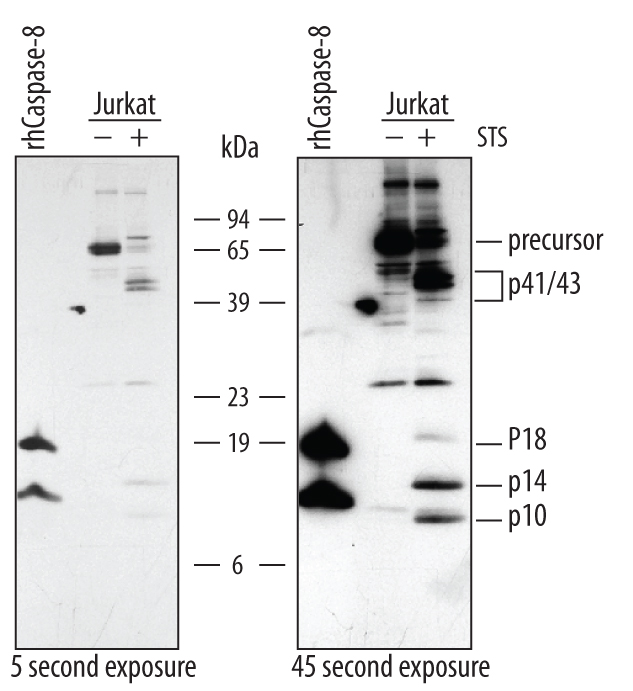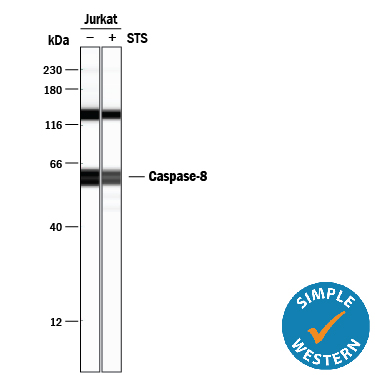Human/Mouse Caspase-8 Antibody Summary
Ser217-Asp384 (Asp285His) (p18 subunit), Leu385-Asp479 (p10 subunit)
Accession # Q14790
Applications
Please Note: Optimal dilutions should be determined by each laboratory for each application. General Protocols are available in the Technical Information section on our website.
Scientific Data
 View Larger
View Larger
Detection of Human Caspase‑8 by Western Blot. Western blot shows lysates of Jurkat human acute T cell leukemia cell line untreated (-) or treated (+) with 1 mM staurosporine (STS) for for 3 hours. PVDF membrane was probed with 0.5 µg/mL of Rabbit Anti-Human/Mouse Caspase-8 Antigen Affinity-purified Polyclonal Antibody (Catalog # AF1650), followed by HRP-conjugated Anti-Rabbit IgG Secondary Antibody (Catalog # HAF008). For additional reference Recombinant Human Caspase-8 (Catalog # 705-C8) was included. Specific bands were detected for Caspase-8 precursor at approximately 57-60 kDa (as indicated). In STS-treated samples, specific bands were detected for Caspase-8 p41/43 subunit at approximately 41 and 43 kDa (as indicated) and Caspase-8 p18, p14, and p10 subunits at approximately 18 kDa, 14 kDa, and 10 kDa, respectively (as indicated). This experiment was conducted under reducing conditions and using Immunoblot Buffer Group 4.
 View Larger
View Larger
Detection of Human Caspase‑8 by Simple WesternTM. Simple Western lane view shows lysates of Jurkat human acute T cell leukemia cell line untreated (-) or treated (+) with 1 mM Staurosporine (STS) for 3 hours, loaded at 0.2 mg/mL. Specific bands were detected for Caspase‑8 at approximately 58-62 kDa (as indicated) using 5 µg/mL of Rabbit Anti-Human/Mouse Caspase‑8 Antigen Affinity-purified Polyclonal Antibody (Catalog # AF1650). This experiment was conducted under reducing conditions and using the 12-230 kDa separation system.
Reconstitution Calculator
Preparation and Storage
- 12 months from date of receipt, -20 to -70 °C as supplied.
- 1 month, 2 to 8 °C under sterile conditions after reconstitution.
- 6 months, -20 to -70 °C under sterile conditions after reconstitution.
Background: Caspase-8
Caspase-8 (Cysteine-aspartic acid protease 8/Casp8a; also named MCH5, FLICA and MACH alpha 1) is a 28 kDa member of the peptidase C14A family of enzymes (1, 2, 3). It is widely expressed and is considered an initiating caspase for the apoptotic cascade (4). Caspase-8 acts on a wide variety of substrates, including procaspases-3, 4, 6, 7, 9 and 10, c-FLIPL and procaspase-8 itself (1, 5, 6). Human procaspase-8a is a 54‑56 kDa, 479 amino acid (aa) protein (4, 7, 8, 9). It contains two N-terminal death domains (aa 1‑177), followed by a catalytic site that utilizes His317Gly318 plus Cys360. Normally, it is an inactive, cytosolic monomer (1, 10, 11). But following death-domain (DD) containing receptor oligomerization, Caspase-8 is recruited to the death-inducing signaling complex (DISC) that forms around the death domains of the oligomerized receptor (12). FADD/CAP-1 is recruited first, followed by procaspase-8/CAP-4 and, possibly, c-FLIPL and procaspase-10 (12). The recruitment, or concentration, of procaspase-8 induces homodimerization. This act alone is sufficient for activation. However, the activity level is modest at best, and appears to be directed towards either itself, or c-FLIPL, which is known to form a functional heterodimer with procaspase-8 (5, 11). When directed towards itself, autocleavage occurs first between Asp374Ser375, generating a 43 kDa (p43) N-terminal (aa 1‑374) and an 11 kDa C-terminal (aa 375 - 479) fragment. The C-terminus is further cleaved between Asp384Leu385 to generate a mature p10 subunit (aa 385‑479). The p43 subunit is next cleaved twice, once between Asp216Ser217, and again between Asp210Ser211 to generate a 26 kDa DD-containing prodomain (aa 1‑210) with an additional 18 kDa mature p18 subunit (aa 217‑374) (12). p18 and p10 noncovalently associate to form a 28 kDa heterodimer, which subsequently associates with another p18:p10 heterodimer to form an active, mature Caspase-8 molecule. This leaves the DISC to act on downstream apoptotic procaspases. In the event procaspase-8 comes to the DISC complexed with c-FLIPL, c-FLIPL will be cleaved by procaspase-8, generating a p43 fragment that is analogous to the Caspase-8 p43 subunit. This fragment, however, appears not to be an intermediate in a proteolytic cascade. Rather, it serves as a functional subunit, interacting with TRAF2 and activating NF kappa B. This may account for many of the nonapoptotic activities associated with Caspase-8 (5, 6, 13). Mature human and mouse Caspase-8a heterodimers are 73% aa identical (14).
-
Chowdhury, I. et al. (2008) Comp. Biochem. Physiol. B 151:10.
-
Boatright, K.M. & G.S. Salvesen (2003) Curr. Opin. Cell Biol. 15:725.
-
Launay, S. et al. (2005) Oncogene 24:5137.
-
Srinivasula, S.M. et al. (1996) Proc. Natl. Acad. Sci. USA 93:14486.
-
Hughes, M.A. et al. (2009) Mol. Cell 35:265.
-
Lamkanfi, M. et al. (2007) Cell Death Differ. 14:44.
-
Fernandes-Alnemri, T. et al. (1996) Proc. Natl. Acad. Sci. USA 93:7464.
-
Boldin, M.P. et al. (1996) Cell 85:803.
-
Muzio, M. et al. (1996) Cell 85:817.
-
Donepudi, M. et al. (2003) Mol. Cell 11:543.
-
Boatright, K.M. et al. (2003) Mol. Cell 11:529.
-
Golks, A. et al. (2006) Cell Death Differ. 13:489.
-
Scaffidi, C. et al. (1997) J. Biol. Chem. 272:26953.
-
Sakamaki, K. et al. (1998) Eur. J. Biochem. 253:399.
Product Datasheets
Citations for Human/Mouse Caspase-8 Antibody
R&D Systems personnel manually curate a database that contains references using R&D Systems products. The data collected includes not only links to publications in PubMed, but also provides information about sample types, species, and experimental conditions.
11
Citations: Showing 1 - 10
Filter your results:
Filter by:
-
Caspase-8 is required for HSV-1-induced apoptosis and promotes effective viral particle release via autophagy inhibition
Authors: F Marino-Mer, A Klett, E Papaianni, SFA Drago, B Macchi, MG Rincón, F Andreola, A Serafino, S Grelli, A Mastino, C Borner
Cell Death and Differentiation, 2022-11-24;0(0):.
Species: Complex Species Category
Sample Types: Cell Lysates
Applications: Western Blot -
Targeting Cpt1a-Bcl-2 interaction modulates apoptosis resistance and fibrotic remodeling
Authors: L Gu, R Surolia, JL Larson-Cas, C He, D Davis, J Kang, VB Antony, AB Carter
Cell Death and Differentiation, 2021-08-20;0(0):.
Species: Mouse
Sample Types: Cell Lysates
Applications: Western Blot -
Complement-5 inhibition deters progression of fulminant hepatitis to acute liver failure in murine models
Authors: J Kusakabe, K Hata, H Miyauchi, T Tajima, Y Wang, I Tamaki, J Kawasoe, Y Okamura, X Zhao, T Okamoto, T Tsuruyama, S Uemoto
Cellular and Molecular Gastroenterology and Hepatology, 2021-01-12;0(0):.
Species: Mouse
Sample Types: Tissue Homogenates
Applications: Western Blot -
AFP promotes HCC progression by suppressing the HuR-mediated Fas/FADD apoptotic pathway
Authors: T Chen, X Dai, J Dai, C Ding, Z Zhang, Z Lin, J Hu, M Lu, Z Wang, Y Qi, L Zhang, R Pan, Z Zhao, L Lu, W Liao, X Lu
Cell Death Dis, 2020-10-02;11(10):822.
Species: Human
Sample Types: Cell Lysates
Applications: Western Blot -
Ferrichrome identified from Lactobacillus casei ATCC334 induces apoptosis through its iron-binding site in gastric cancer cells
Authors: M Ijiri, M Fujiya, H Konishi, H Tanaka, N Ueno, S Kashima, K Moriichi, J Sasajima, K Ikuta, T Okumura
Tumour Biol., 2017-06-01;39(6):1010428317711.
Species: Xenograft
Sample Types: Cell Lysates
Applications: Western Blot -
The expression of the Sprouty 1 protein inversely correlates with growth, proliferation, migration and invasion of ovarian cancer cells.
Authors: Masoumi-Moghaddam, Samar, Amini, Afshin, Ehteda, Anahid, Wei, Ai-Qun, Morris, David La
J Ovarian Res, 2014-06-08;7(0):61.
Species: Human
Sample Types: Whole Cells
Applications: Western Blot -
NRBF2 regulates autophagy and prevents liver injury by modulating Atg14L-linked phosphatidylinositol-3 kinase III activity.
Authors: Lu, Jiahong, He, Liqiang, Behrends, Christia, Araki, Masatake, Araki, Kimi, Jun Wang, Qing, Catanzaro, Joseph M, Friedman, Scott L, Zong, Wei-Xing, Fiel, M Isabel, Li, Min, Yue, Zhenyu
Nat Commun, 2014-05-22;5(0):3920.
Species: Mouse
Sample Types: Whole Tissue
Applications: IHC -
TCEA3 binds to TGF-beta receptor I and induces Smad-independent, JNK-dependent apoptosis in ovarian cancer cells.
Authors: Cha Y, Kim D, Hyun J, Kim S, Park K
Cell Signal, 2013-01-26;25(5):1245-51.
Species: Human
Sample Types: Cell Lysates
Applications: Western Blot -
Hyperactivation of the mammalian degenerin MDEG promotes caspase-8 activation and apoptosis.
Authors: Pan, Ji-An, Fan, Yongjun, Gandhirajan, Rajesh K, Madesh, Muniswam, Zong, Wei-Xing
J Biol Chem, 2012-12-13;288(5):2952-63.
Species: Mouse
Sample Types: Cell Lysates
Applications: Western Blot -
Inhibition of protein degradation induces apoptosis through a microtubule-associated protein 1 light chain 3-mediated activation of caspase-8 at intracellular membranes.
Authors: Pan JA, Ullman E, Dou Z
Mol. Cell. Biol., 2011-05-31;31(15):3158-70.
Species: Human
Sample Types: Cell Lysates
Applications: Western Blot -
Theiler's virus-induced intrinsic apoptosis in M1-D macrophages is Bax mediated and restricts virus infectivity: a mechanism for persistence of a cytolytic virus.
Authors: Son KN, Becker RP, Kallio P, Lipton HL
J. Virol., 2008-02-20;82(9):4502-10.
Species: Mouse
Sample Types: Whole Cells
Applications: Neutralization
FAQs
No product specific FAQs exist for this product, however you may
View all Antibody FAQsReviews for Human/Mouse Caspase-8 Antibody
There are currently no reviews for this product. Be the first to review Human/Mouse Caspase-8 Antibody and earn rewards!
Have you used Human/Mouse Caspase-8 Antibody?
Submit a review and receive an Amazon gift card.
$25/€18/£15/$25CAN/¥75 Yuan/¥2500 Yen for a review with an image
$10/€7/£6/$10 CAD/¥70 Yuan/¥1110 Yen for a review without an image


